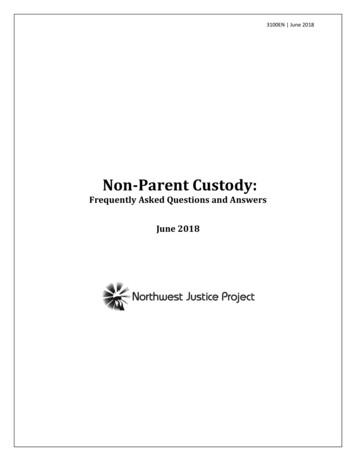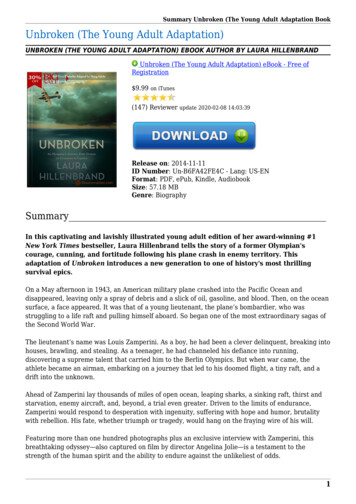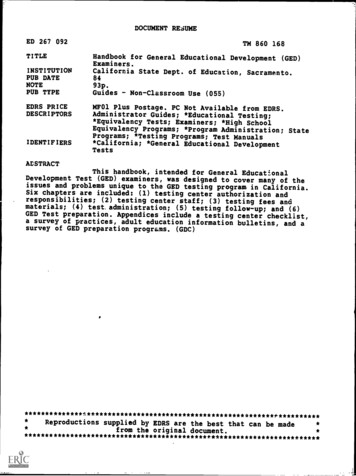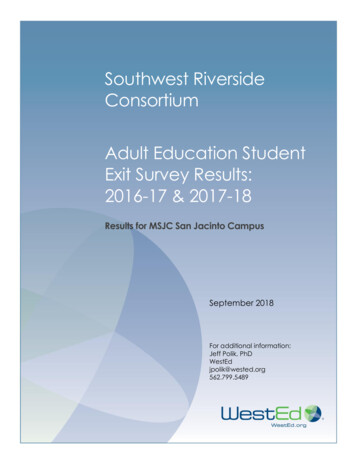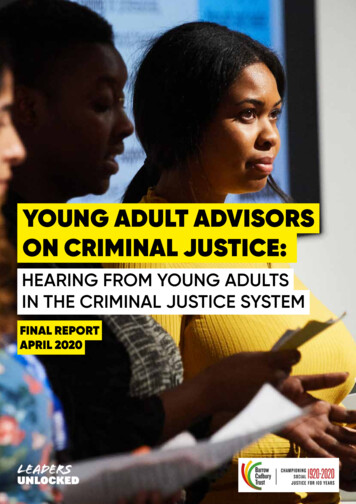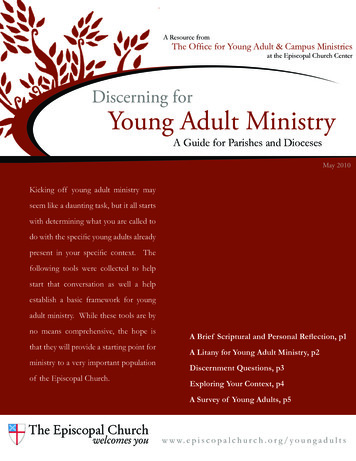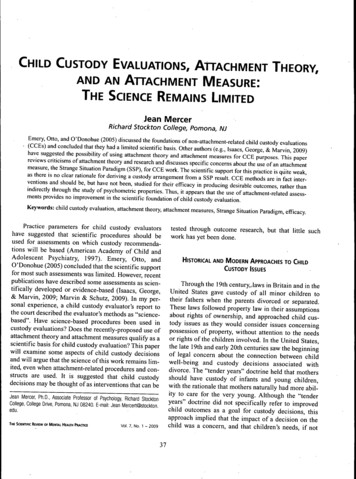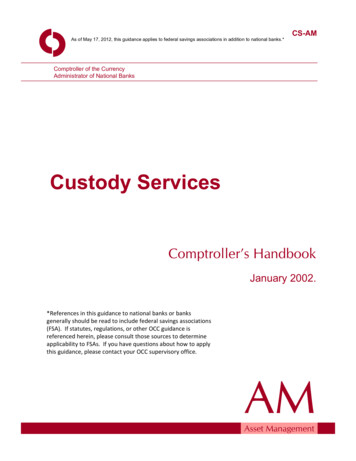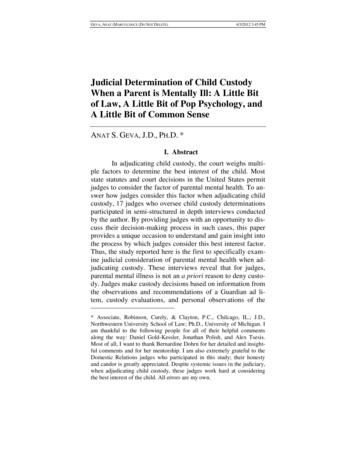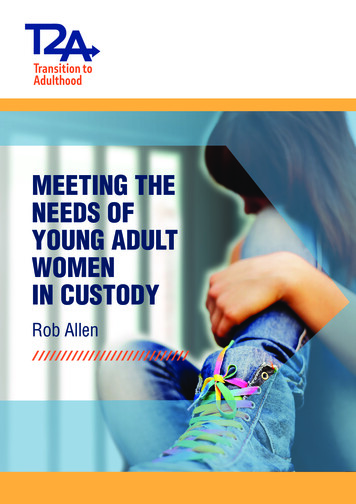
Transcription
MEETING THENEEDS OFYOUNG ADULTWOMENIN CUSTODYRob Allen
is convenedand funded by:About T2A AllianceThe T2A Alliance is a broad coalition of organisations, whichevidences and promotes the need for a distinct approach toyoung adults (18-24 year olds) throughout the criminal justiceprocess. Building on the work of the 2005 Commission onYoung Adults and the Criminal Justice System, the T2A Alliancewas convened by the Barrow Cadbury Trust in 2008. T2A hasproduced more than 40 research and policy reports, and hasworked with researchers, experts, professional bodies, policymakers and service users to make its case for w Cadbury TrustKean House6 Kean StreetLondonWC2B 4ASt 020 7632 9060Registered Charity: 1115476About the AuthorRob Allen is an independent researcher and co-founder ofJustice and Prisons (www.justiceandprisons.org). Rob wasdirector of the International Centre for Prison Studies (ICPS)at King’s College London from 2005 until 2010 and was amember of the Youth Justice Board from 1998 to 2006. Hehas written widely on youth and criminal justice in the UK andabroad. Rob was Chair of the T2A Alliance from 2008-10.In 2013 he wrote ‘Young Adults in Custody – the way forward’for T2A.AcknowledgementsThe author would like to thank those who participated in theroundtable event which took place in London in August 2015to discuss the draft report and Jenny Earle at Prison ReformTrust for commenting on the draft.Published February 2016 T2A, 2016Cover photograph and page 3: library image posed by modelsPhotographs pages 13, 21 prisonimage.org
CONTENTSIntroduction3The current situation5a) Numbers5b) Characteristics and needs6c) Young women’s experiences in custody7Where are young adult women held?9Living arrangements for young adults10Standards and expectations for young adult women in custody11Key issuesMeeting specific needs1313a) Education and activities14b) Substance misuse15c) Suicide and self-harm15d) Violence and anti-social behaviour16e) Incentives, earned privileges and discipline17f) Resettlement17International perspectives and the way forward19Conclusion21Further reading23Meeting the needs of young adult women in custody1
2Meeting the needs of young adult women in custody
INTRODUCTIONYOUNG ADULTWOMEN CAN BEA PARTICULARLYVULNERABLEGROUPThis report looks at how best the prison systemcan meet the needs of young adult women.It follows T2A’s 2013 report ‘Young Adults inCustody: the way forward’ which considered thebroader issues relating to young adults in prison.That report coincided with proposals by theCoalition Government to dispense with specificyoung offender institutions (YOIs) and instead todetain young adults in mixed establishments - apractice that has been increasing over the lastfew years1. The Government’s plans were puton hold pending the outcome of Lord Harris’sindependent review into self-inflicted deaths incustody of 18-24 year olds which reported onJuly 1st 2015.2 The Government respondedto the review in December 2015.3 In themeantime the House of Commons Justice SelectCommittee has embarked on a major inquiry intoyoung adults in the criminal justice ploads/system/uploads/attachment parliament-2015/young-adult-offenders/Meeting the needs of young adult women in custody3
IntroductionIn preparing Young Adults in Custody: the wayforward, it became clear to me that one groupwhose needs have not been fully analysed wereyoung adult women. There is no real consensusabout the best types of custodial orders oraccommodation that should be provided foryoung adult women. Indeed there is a paradoxin the fact that girls under 18 are nowadaysdeemed vulnerable enough to be accommodatedoutside the prison system altogether - in securechildren’s homes or secure training centres.When they reach 18, however, all young adultwomen in custody are held not only in prisons butco-located with older women prisoners. In theirresponse to the Justice Committee’s 2015 reporton Prisons, the Government noted that researchwhich informed their review of the Women’sCustodial Estate (undertaken in 2013) “concludedthat the needs of young adult women and olderwomen were not sufficiently different to warrantdeveloping a separate service for young adultwomen”.5While the specific arrangements made to meetthe needs of young adult women vary fromone establishment to another, the system as awhole has developed in a pragmatic rather thanprincipled fashion.The Government’s 2013 consultation paper onYOIs centred largely on proposals for improvingthe system for young men rather than youngwomen.Similarly, the Harris Review did give someconsideration to the needs of young women butthe bulk of its recommendations concern youngmen. The report was clear however that youngadult women can be a particularly vulnerablegroup, a fact confirmed by the young adultwomen who came to speak to the Harris Reviewinquiry team.6The T2A report did make some recommendationsabout young adult women - for examplesuggesting that the Prison Service Order (PSO)prescribing the management of young adultwomen should be revised in order to promotegood practices and interventions relating toviolence and abuse counselling, and help toraise self-esteem and resist peer pressure. Therewas not scope within the original T2A researchto analyse in detail what might be needed or tooutline learning from good practices in the UKand abroad. This report seeks to address thatomission.The report has been compiled following aliterature review, an analysis of prison statisticsand of Prisons Inspectorate and other reportsabout women’s prisons as well as visits to fourprison establishments. Discussions were heldwith a number of young women prisoners andstaff. An expert seminar was held to discuss adraft of the report in August 2015.The Government’s paper did recognise thatfemale offenders may have some different needsand risks and that there may also be differencesin the nature and drivers of violence amongstyoung adult females compared with youngadult males. But these issues were not furtheraddressed in any detail.5. Government Response to the Justice Committee’s Ninth Report of Session2014-15 Prisons: Planning and Policies4Meeting the needs of young adult women in custody6. ntent/uploads/2015/07/Harris-Review-Report2.pdf 4.33
THE CURRENT SITUATIONa) NumbersIn 2014, 402 young women aged 18 to 20 werereceived into prison under sentence, (out of atotal of 7,033 women). Of the 402, 220 weresentenced to six months or less7 as shown inChart 1. A further 808 21-24 year olds receivedimmediate prison sentences.8Chart 1: 18-20 yr old women sentenced toprison in 2014IndeterminateFine DefaulterThe number of receptions and the averagepopulation of young adult women has fallensubstantially in recent years. 18-24 year oldwomen as a percentage of the total female prisonpopulation fell from 24% in 2008 to 16% in 2014.As Her Majesty’s Inspectorate of Prisons (HMIP)have put it, “the reduction in young adults overrecent years in total and as a percentage of thetotal prison population has been significant, andis to be welcomed. However, those who remainare some of the most vulnerable, troubled youngadults and have complex needs12.Chart 2: 18-20 year old Females under sentenceby OffenceOver 4 yearsOther1 yr - 4yrsNot recordedCriminaldamageand arsonSexualViolenceDrugs6 months -1yr6 months or lessTheftOn 30 June 2015, there were 171 young womenaged 18, 19 and 20 in prison out of a totalwomen’s prison population of 3,904.9 Of the171, 132 were serving a custodial sentence, 26were on remand awaiting trial and 13 had beenconvicted and were awaiting sentence.10A further 366 women were in the 21-24 agegroup, of which 72 were on remand and 294serving sentences.117. Prison receptions 2014 Table A2.1 r2014-and-annual8. Prison Receptions 2014 Table A2.3 r2014-and-annual9. Prison Population 2015 015 TableA1.7: Prison population under 21 by type of custody and sex and TableA1.6: Prison population by type of custody, age and sexRobberyChart 2 shows that of the 132 18-20 year oldfemales serving prison sentences at the end ofJune 2015, 43 had been convicted of violentoffences, 23 of robbery, 20 of theft and 17 ofdrugs offences.13 While young women are morelikely than older ones to be in prison for violentoffences, women’s offending is, for the most part,not of the most serious nature.10. ibid11. Prison Population 2015 Table A1.6: Prison population by type of custody,age and sex 1512. HMIP Submission to the Harris Review13. Prison Population 2015 015 TableA1.3b: Prison population under an immediate custodial sentence byoffence group, age group and sexMeeting the needs of young adult women in custody5
The current situation for young adult women in custodyThe 2015 Conservative Manifesto promised to“improve the treatment of women offenders,exploring how new technology may enablemore women with young children to serve theirsentence in the community”, but at the time ofwriting no details have emerged about how thiswill be implemented.In view of the fact that half of 18-20 year oldwomen sentenced to prison receive sentencesof six months or less, and the fact that over halfof women receiving such prison sentences areconvicted of theft and handling stolen goods,14there is considerable scope for greater use ofcommunity based sentences.While numbers are very small, considerationneeds to be given to meeting the needs ofyoung women facing very long or indeterminatesentences.There is now a statutory obligation on theSecretary of State for Justice to ensure that theneeds of women are addressed in “arrangementsfor the supervision and rehabilitation of personsconvicted of offences” and it is important toensure that this includes the particular needs ofyoung women.15b) Characteristics and needsThere has been little specific research aboutthe characteristics of young adult women incustody. A 2014 report by the Criminal JusticeInspectorates about girls in the criminal justicesystem contained information about undereighteens in custody.16 The small number ofgirls under 18 in custody are currently all heldoutside the prison system, either in SecureChildren’s Homes or Secure Training Centres. TheInspectorate report found that these girls had awide range of complex needs. And earlier studieshave found that almost half of girls in custodyreported having been in care.1714. Immediate custodial sentenced receptions of females, by offence groupand sentence length in 2014, excluding Quarter 2(1), England and i-releases-for-august-201515. S.10 Offender Rehabilitation Act 2014, amending Offender ManagementAct 2007 s 3(6A)16. Criminal-Justice-System.pdf6Meeting the needs of young adult women in custodyIt is almost certainly the case that young adultwomen in custody share these characteristics.Many will have suffered from abuse andtrauma and experience mental health andaddiction problems. Some of the experiencesyoung women have in prison may compoundthe damaging experiences of childhood andadolescence, but a period in custody may alsooffer the chance to make a fresh start and toaddress some of the underlying problems whichhave led young women into trouble. INQUEST’ssubmission to the Harris Review noted that“many young women enter the criminal justicesystem as a result of unmet welfare needsincluding neglect, abuse and poverty” (p 23).Women in Prison in their submission suggestedthat women have high rates of trauma,victimisation, substance misuse and mentalhealth issues. Following her visit to the UK in2014, the UN Special Rapporteur on Violenceagainst Women recommended the establishmentof specific safeguards to ensure that women’shistories of victimisation and abuse are takeninto consideration when making decisions aboutincarceration, especially for non-violent crimes.18Women in Prison have argued that furtherresearch is needed on the specific needs ofyoung adults. Young adulthood “is a time ofsignificant hormonal change for young men andyoung women. The impacts of these hormonalchanges and the way they affect behaviour,resilience and feelings of being able to copein both young men and young women shouldbe further explored and considered in theidentification of and response to vulnerability”19NOMS has recently recognised that “the partsof the brain associated with impulse control, andregulation and interpretation of emotions, are thelast to mature, and continue to develop well intoadulthood. This means that control over impulsesand emotions is likely to be poorer amongyounger adult women”.2017. Tye D 200918. UN A/HRC/29/27/Add.219. Women in Prison submission to Harris Review20. NOMS Better Outcomes for Women Offenders, September 2015
The current situation for young adult women in custodyNOMS has also noted that “younger women areparticularly susceptible to the influence of peers,as they are still in the process of developinga stable identity. It is particularly important topromote the development of a healthy, prosocial identity in younger adults, to provide apositive influence on their development, andto help young women become more selfsufficient and less reliant on others”. Women’soffending is often driven by abusive and coerciverelationships, and this may be particularly true foryoung women.21Recently available data has not surprisingly foundthat young adult women in prison are much lesslikely to be mothers of dependent children thanare older women. In 2012, between 3% and4% of 18-20 year olds in prison are estimatedto have had dependent children compared to24-31% of women overall. 16-21% of womenin the 21-24 age group are thought to havebeen mothers.22 While numbers are small, it isimportant that appropriate provision is made forthem.c) Young women’s experiences incustodyThere is limited recent evidence about whatyoung women think of their time in prison. AThematic review published by HMIP in 2010 drewon survey data from 2006-8.23 This found that for66 (35%) of the survey questions young womenreported a poorer experience than women aged21 and over and a better experience for 27(14%) of the questions. There was no significantdifference for the other 98 questions.Young adult women reported a poorer experiencein the first few days and were less likely to havefelt safe on their first night. They were also morelikely to have felt threatened or intimidated bystaff, and say that staff had made insultingremarks about them or their family. They reporteda poorer experience on wings, such as havingaccess to clean clothes and showers, and onlya quarter (24%) said that the food was goodcompared with 38% of women aged 21 and over.Young adult women were also less likely to feelthat staff treated them with respect or report thatthey had been involved in activities in the prison.However, young adult women were more positiveabout visits and staff help in maintaining contactwith family and friends.More recently it has become clear that particularattention is required to meet the needs ofyoung women who move into the adult prisonsystem from the juvenile estate. HMIP havefound that the small number of young womenentering prison from Secure Training Centresneed particular support to integrate into themain population. “Holloway showed what canbe done to support this vulnerable and needygroup”.24 Staff at Peterborough Prison visit girlsat the Secure Training Centre in order to preparethem for the forthcoming move.25 At our expertseminar it was suggested that what might behelpful is for young women to be enabled tospend a weekend at the adult prison before beingtransferred. In a discussion group in an adultprison, a young woman who had moved froman STC ten days after her eighteenth birthdayexplained how different the experience was andhow ill-prepared she had been for the change.Without support, her first weeks in the new prisonwere marked by her ‘kicking off’ and spendingtime in segregation.More broadly, it is the attitudes and behaviourof staff which seems key to ensuring that youngadults are appropriately managed within theprison setting. The Harris Review concludedthat “those working with these very vulnerableyoung people need to have the necessaryskills to support them through the custodyprocess.” This involves an understanding ofthe social care elements of the role as well assecurity. In discussion with young women inprison undertaken as part of this research, most21. Prison Reform Trust briefing Why Focus on reducing women’simprisonment, July 201524. wp-content/uploads/sites/4/2014/10/HMIP-AR 2013-141.pdf22. Female offenders and child dependents Ministry of Justice25. Interview23. -short-thematic-2010-rps-.pdfMeeting the needs of young adult women in custody7
The current situation for young adult women in custodysuggested that staff needed to show greaterpatience, tolerance and flexibility in applyingstandards and rules - although one young womansaw merit in a more military approach. The needto improve the ratio of female to male prisonofficers and governors is often commented onin HMIP inspections of women’s prisons, andthis is particularly important when there areyoung vulnerable women to manage. When thePrison and Probation Ombudsman looked atwhy women and young people in custody donot tend to make formal complaints, they found“widespread mistrust of the internal complaintssystem, fear of reprisal and a belief that formalcomplaints were a waste of time as they wouldnot be dealt with, or would be tampered with bystaff.”26 For Women in Prison, training in genderresponsive and trauma-informed ways of workingare required. It is encouraging that in a numberof settings accreditation is being sought as an‘enabling environment’ - that is a place wherepositive relationships promote well-being forprisoners and staff alike.27 2015 has seen trainingsessions on trauma-informed practice in mostwomen’s prisons.28There are still, however, some fundamentalweaknesses to overcome. There was consensusat our expert seminar that there are insufficientstaff in women’s prisons - the ratio of one staffmember for 24 prisoners was considered too highand made no allowance for the greater needsof young adults. In London at least, staff are notrecruited specifically to a women’s prison butallocated after a three day training course.While resolving such matters requires longterm cultural change, there are some morestraightforward practical issues which can startto help to make young women’s time in prisonless damaging. At one prison, young womenwere made to feel more comfortable by beinggiven duvets rather than blankets and to maketheir cells more homely than is strictly permitted26. rmal-complaints final.pdf#view FitH27. http://www.enablingenvironments.com/28. e-covington-atdrake-hall/8Meeting the needs of young adult women in custodyby the rules. A number of establishments havedeveloped ways of enabling young womento buy cheap or second-hand, but stylish,clothes. In another, the Independent MonitoringBoard reported that while older prisoners ingeneral consider that food portions are usuallysatisfactory, “many younger women find thatthey are inadequate”29. Focusing on where youngwomen stay, what they wear and what they eatseem to be the basic building blocks from whichan age appropriate environment can be created.MORE BROADLY, ITIS THE ATTITUDESAND BEHAVIOUR OFSTAFF WHICH SEEMKEY TO ENSURINGTHAT YOUNG ADULTSARE APPROPRIATELYMANAGED WITHIN THEPRISON SETTING29. tyal-2014-15.pdf
The current situation for young adult women in custodyWhere are young adult women held?There are no Young Offender Institutions whichexclusively accommodate young adult women.All young adult women in custody are mostlyintegrated with adults in the prison system. At thetime of writing, there are 11 women’s prisons inEngland and Wales which take young women.1 Askham Grange, (York) is an open prison forsentenced adult and young adult women. In July2014 it had an operational capacity of 128 and apopulation of 100. There was one young offenderunder the age of 21.302 Bronzefield, (Greater London) is a privately-runprison with an operational capacity of 527. InApril 2013 it held 446 women of whom 22 wereyoung offenders.31 According to the 2013-14Independent Monitoring Board (IMB) report itholds approximately 50 young offenders agedbetween 18-21 who are accommodated in thesame house blocks as the adult women.327 Holloway, (Greater London), has a capacity of591 of whom about 5% are young women agedbetween 18-20.368 Low Newton, (Durham), has a capacity of 329.In September 2014 there were 298 women ofwhom 10 were under 21.9 New Hall, (West Yorkshire) can accommodate upto 415 residents from the age of 18.37In February 2012 just under 10% of thepopulation was under 21.3810 Peterborough, (Cambridgeshire), is a privatelyrun prison with a capacity of 384. One of its 10wings is for 18-25 year olds.39 In June 2014there were 25 young adults aged 18-20.11 Styal, (Cheshire), has a capacity of 460 and 20young adults.813 Drake Hall, (Staffordshire), is a closed prison9for women with a capacity of 315. According tothe 2013-14 IMB report, the number of youngoffenders out of the total averaged nine.33114 East Sutton Park, (Kent), is an open prison witha capacity of 92 women of whom eight are youngoffenders.3436105 Eastwood Park, (Gloucestershire) has acapacity of 363 with 293 adult places, 58 youngoffender places, and 12 places for mothers andup to 13 babies.356 Foston Hall, (Derbyshire), is a local women’sclosed establishment, which holds remand,unsentenced, short and long-term young adultsand adult prisoners, including those serving lifesentences. It has a capacity of 304.527430. web-2014.pdf36. 1. df37. ew-hall-2013-14.pdf32. ronzefield-2013-14.pdf33. rake-hall-2013-14.pdf.pdf38. 9. eb-2014.pdf34. page/2/35. page/2/Meeting the needs of young adult women in custody9
The current situation for young adult women in custodyLiving arrangements for young adultwomenThe arrangements for accommodating youngwomen in these establishments vary, but in mostyoung adults are fully integrated with the adultpopulation.At Holloway in 2013 HMIP found that the smallnumber of young adults were integrated withthe adult population and staff knew who theywere. They received some support and most ofthose with whom the inspectors spoke felt welllooked after. Our expert seminar heard how thedecision to integrate young adults some yearsback had led to reductions in violence and selfharm, thanks in part to the quasi-parenting roleprovided by some of the older women prisoners.At Bronzefield, by contrast, in 2013, inspectorswere not assured that the distinct needs ofthe sometimes very young women held wereidentified or met. Twenty-two young adults wereaccommodated within the general population; theyoungest was 18.At Low Newton, according to the IMB adultprisoners and young offenders are integrated.There are no more than 30% of young offenderson each wing, with risk assessments carried outbefore it is decided on which wing a particularyoung woman should be located. HMIP foundthat most felt well cared for but would havevalued the opportunity to participate in a forumspecifically dedicated to their age group. HMIPalso questioned the placement of young adultson wings catering for long-term prisoners.At Eastwood Park “the prison managementand some prisoners felt that the challengesof managing young adults had been reducedby mixing them with adults,” but HMIP wereconcerned that their specific needs were notidentified and addressed in a number of areas.HMIP recommended that young adults should belocated together, where there is specific regimeprovision and staff dedicated to them.40. Interview with staff member41. Personal communication staff member10 Meeting the needs of young adult women in custodySome prisons do accommodate young adults ina specific location. At Peterborough, there is aspecific wing dedicated to women under the ageof 25 and HMIP found that young adults wereprovided with some very good specific support.At East Sutton Park young adult women areaccommodated together in one room. Inspectorsconsidered furnishings were sparse and womenhad to share the single chair, table and televisionavailable. At Drake Hall, young offenders werepreviously accommodated together in one ofthe 15 residential units but this had become,in the words of one interviewee, somethingof a “party house”40. Young women are nowintegrated into the wider prison community andaccording to HMIP this appears to have workedwell. In another prison, four young women on theenhanced privilege level were allowed to share adormitory but within a week all were back on thebasic level.41At Eastwood Park HMIP found 21 young womenaged 18 to 20 were accommodated withinthe general population. They were allocatedto particular dedicated cells but were notformally recognised as having specific needswithin the institution’s equality protocol. AtNew Hall, “some younger women wanted moreopportunities to interact socially with others of asimilar age in other houses”.42In discussions with young offenders in prison,a number of tensions were mentioned betweenolder and younger prisoners. Young women forexample like to play loud music and on occasionwander around the units in their pyjamas(although this is against the rules). Youngerwomen admitted to mocking some of the olderprisoners too. For these and other reasonsyoung women are not always popular with olderprisoners. In another prison where there are no18-20 year olds but about 10% of the populationis aged 21-24, staff described the youngerprisoners as “louder and more argumentative”.42. Report on an unannounced inspection of HMP & YOI New Hallby HM Chief Inspector of Prisons8–19 June 2015 015.pdf
The current situation for young adult women in custodyGiven the numbers involved, there may notbe a strong case for developing specificestablishments for young adult women. Furtherresearch is however needed to identify if betteroutcomes are achieved when young womenare simply mixed with the adult population,or accommodated in separate wings, units orlocations within adult prisons.Consideration also needs to be given of thekinds of risk and needs assessments that shouldbe completed when integrating young adultwomen with women over the age of 21 and tostrengthening the case management of youngwomen so that their experience in custody is aspositive as possible.Women’s prisons may also benefit from thedevelopment of specialist approaches such asthose provided at HMP Send. While the prisontakes women only from the age of 21, its rangeof provision for women facing particular kinds ofchallenges (whether with drugs, mental health orother problems) offers the opportunity for a moreindividualised approach than is usual.Standards and expectations for youngadult women in custodyPrisons for men and those for women generallyoperate within the same rules and policies.These comprise the Prison Act, the PrisonRules and, for under-21-year-olds, the YoungOffender Institution Rules. All women’s prisonsare additionally required to comply with genderspecific standards for working with womenprisoners, which are set out in Prison ServiceOrder PSO 4800, one of the long-term mandatoryinstructions which regulate how prisons are run.The aim of PSO 4800 is to enable staff to beaware of the gender specific issues that affectwomen prisoners and respond appropriately.PSO 4800 includes some specific guidance abouthow prison establishments should meet theneeds of young women.4343. https://www.justice.gov.uk/offenders/psosThe PSO points out the need to addressvulnerabilities such as high levels of self-harm,mental health needs and victimisation from theirpeer group. The PSO also says that youngerprisoners wil
Young Adults and the Criminal Justice System, the T2A Alliance was convened by the Barrow Cadbury Trust in 2008. T2A has produced more than 40 research and policy reports, and has . Kean House 6 Kean Street London WC2B 4AS t 020 7632 9060 Registered Charity: 1115476 is convened and funded by:
